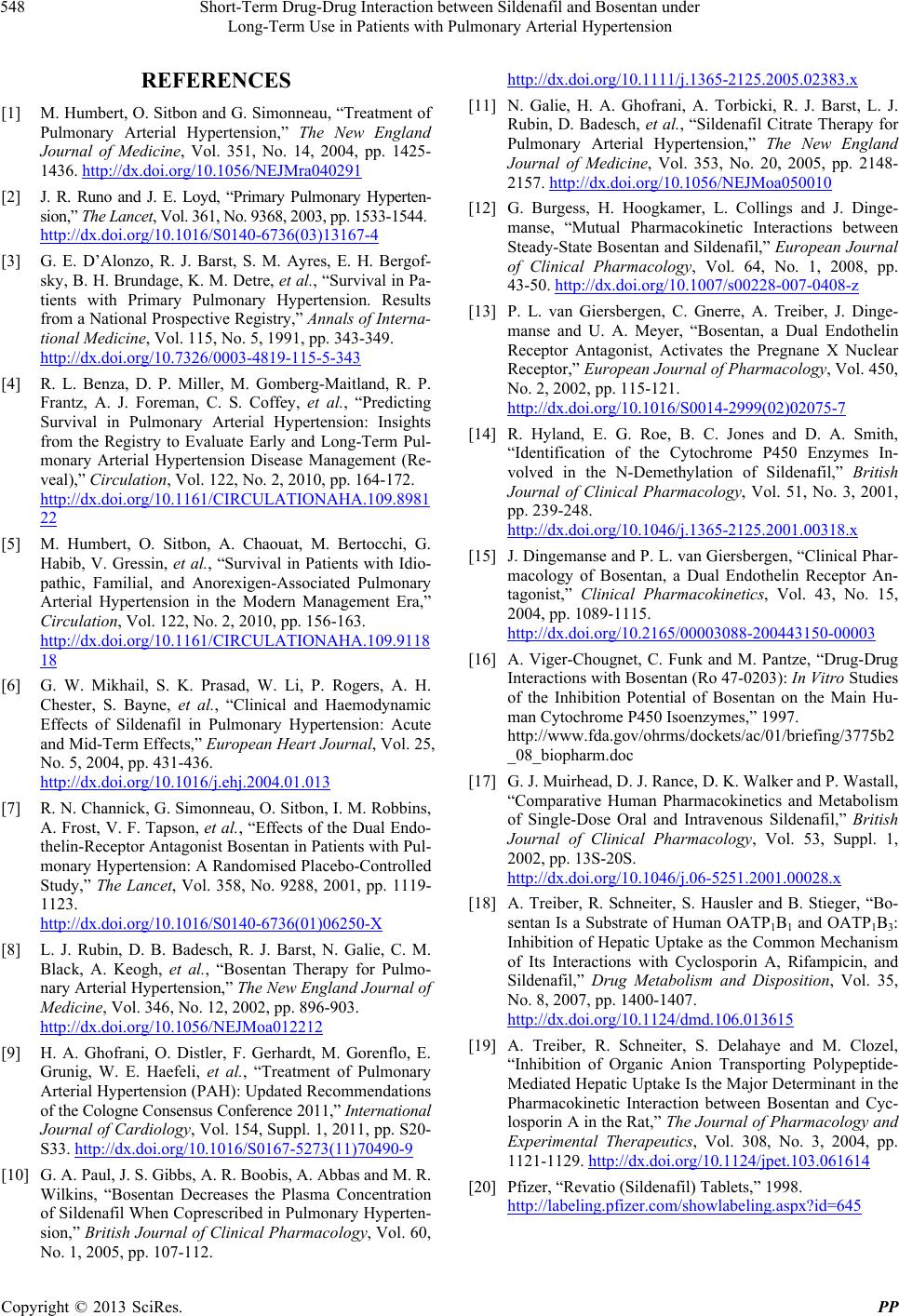
Short-Term Drug-Drug Interaction between Sildenafil and Bosentan under
Long-Term Use in Patients with Pulmonary Arterial Hypertension
Copyright © 2013 SciRes. PP
548
REFERENCES
[1] M. Humbert, O. Sitbon and G. Simonneau, “Treatment of
Pulmonary Arterial Hypertension,” The New England
Journal of Medicine, Vol. 351, No. 14, 2004, pp. 1425-
1436. http://dx.doi.org/10.1056/NEJMra040291
[2] J. R. Runo and J. E. Loyd, “Primary Pulmonary Hyperten-
sion,” The Lancet, Vol. 361, No. 9368, 2003, pp. 1533-1544.
http://dx.doi.org/10.1016/S0140-6736(03)13167-4
[3] G. E. D’Alonzo, R. J. Barst, S. M. Ayres, E. H. Bergof-
sky, B. H. Brundage, K. M. Detre, et al., “Survival in Pa-
tients with Primary Pulmonary Hypertension. Results
from a National Prospective Registry,” Annals of Interna-
tional Medicine, Vol. 115, No. 5, 1991, pp. 343-349.
http://dx.doi.org/10.7326/0003-4819-115-5-343
[4] R. L. Benza, D. P. Miller, M. Gomberg-Maitland, R. P.
Frantz, A. J. Foreman, C. S. Coffey, et al., “Predicting
Survival in Pulmonary Arterial Hypertension: Insights
from the Registry to Evaluate Early and Long-Term Pul-
monary Arterial Hypertension Disease Management (Re-
veal),” Circulation, Vol. 122, No. 2, 2010, pp. 164-172.
http://dx.doi.org/10.1161/CIRCULATIONAHA.109.8981
22
[5] M. Humbert, O. Sitbon, A. Chaouat, M. Bertocchi, G.
Habib, V. Gressin, et al., “Survival in Patients with Idio-
pathic, Familial, and Anorexigen-Associated Pulmonary
Arterial Hypertension in the Modern Management Era,”
Circulation, Vol. 122, No. 2, 2010, pp. 156-163.
http://dx.doi.org/10.1161/CIRCULATIONAHA.109.9118
18
[6] G. W. Mikhail, S. K. Prasad, W. Li, P. Rogers, A. H.
Chester, S. Bayne, et al., “Clinical and Haemodynamic
Effects of Sildenafil in Pulmonary Hypertension: Acute
and Mid-Term Effects,” European Heart Journal, Vol. 25,
No. 5, 2004, pp. 431-436.
http://dx.doi.org/10.1016/j.ehj.2004.01.013
[7] R. N. Channick, G. Simonneau, O. Sitbon, I. M. Robbins,
A. Frost, V. F. Tapson, et al., “Effects of the Dual Endo-
thelin-Receptor Antagonist Bosentan in Patients with Pul-
monary Hypertension: A Randomised Placebo-Controlled
Study,” The Lancet, Vol. 358, No. 9288, 2001, pp. 1119-
1123.
http://dx.doi.org/10.1016/S0140-6736(01)06250-X
[8] L. J. Rubin, D. B. Badesch, R. J. Barst, N. Galie, C. M.
Black, A. Keogh, et al., “Bosentan Therapy for Pulmo-
nary Arterial Hypertension,” The New England Journal of
Medicine, Vol. 346, No. 12, 2002, pp. 896-903.
http://dx.doi.org/10.1056/NEJMoa012212
[9] H. A. Ghofrani, O. Distler, F. Gerhardt, M. Gorenflo, E.
Grunig, W. E. Haefeli, et al., “Treatment of Pulmonary
Arterial Hypertension (PAH): Updated Recommendations
of the Cologne Consensus Conference 2011,” International
Journal of Cardiology, Vol. 154, Suppl. 1, 2011, pp. S20-
S33. http://dx.doi.org/10.1016/S0167-5273(11)70490-9
[10] G. A. Paul, J. S. Gibbs, A. R. Boobis, A. Abbas and M. R.
Wilkins, “Bosentan Decreases the Plasma Concentration
of Sildenafil When Coprescribed in Pulmonary Hyperten-
sion,” British Journal of Clinical Pharmacology, Vol. 60,
No. 1, 2005, pp. 107-112.
http://dx.doi.org/10.1111/j.1365-2125.2005.02383.x
[11] N. Galie, H. A. Ghofrani, A. Torbicki, R. J. Barst, L. J.
Rubin, D. Badesch, et al., “Sildenafil Citrate Therapy for
Pulmonary Arterial Hypertension,” The New England
Journal of Medicine, Vol. 353, No. 20, 2005, pp. 2148-
2157. http://dx.doi.org/10.1056/NEJMoa050010
[12] G. Burgess, H. Hoogkamer, L. Collings and J. Dinge-
manse, “Mutual Pharmacokinetic Interactions between
Steady-State Bosentan and Sildenafil,” European Journal
of Clinical Pharmacology, Vol. 64, No. 1, 2008, pp.
43-50. http://dx.doi.org/10.1007/s00228-007-0408-z
[13] P. L. van Giersbergen, C. Gnerre, A. Treiber, J. Dinge-
manse and U. A. Meyer, “Bosentan, a Dual Endothelin
Receptor Antagonist, Activates the Pregnane X Nuclear
Receptor,” European Journal of Pharmacology, Vol. 450,
No. 2, 2002, pp. 115-121.
http://dx.doi.org/10.1016/S0014-2999(02)02075-7
[14] R. Hyland, E. G. Roe, B. C. Jones and D. A. Smith,
“Identification of the Cytochrome P450 Enzymes In-
volved in the N-Demethylation of Sildenafil,” British
Journal of Clinical Pharmacology, Vol. 51, No. 3, 2001,
pp. 239-248.
http://dx.doi.org/10.1046/j.1365-2125.2001.00318.x
[15] J. Dingemanse and P. L. van Giersbergen, “Clinical Phar-
macology of Bosentan, a Dual Endothelin Receptor An-
tagonist,” Clinical Pharmacokinetics, Vol. 43, No. 15,
2004, pp. 1089-1115.
http://dx.doi.org/10.2165/00003088-200443150-00003
[16] A. Viger-Chougnet, C. Funk and M. Pantze, “Drug-Drug
Interactions with Bosentan (Ro 47-0203): In Vitro Studies
of the Inhibition Potential of Bosentan on the Main Hu-
man Cytochrome P450 Isoenzymes,” 1997.
http://www.fda.gov/ohrms/dockets/ac/01/briefing/3775b2
_08_biopharm.doc
[17] G. J. Muirhead, D. J. Rance, D. K. Walker and P. Wastall,
“Comparative Human Pharmacokinetics and Metabolism
of Single-Dose Oral and Intravenous Sildenafil,” British
Journal of Clinical Pharmacology, Vol. 53, Suppl. 1,
2002, pp. 13S-20S.
http://dx.doi.org/10.1046/j.06-5251.2001.00028.x
[18] A. Treiber, R. Schneiter, S. Hausler and B. Stieger, “Bo-
sentan Is a Substrate of Human OATP1B1 and OATP1B3:
Inhibition of Hepatic Uptake as the Common Mechanism
of Its Interactions with Cyclosporin A, Rifampicin, and
Sildenafil,” Drug Metabolism and Disposition, Vol. 35,
No. 8, 2007, pp. 1400-1407.
http://dx.doi.org/10.1124/dmd.106.013615
[19] A. Treiber, R. Schneiter, S. Delahaye and M. Clozel,
“Inhibition of Organic Anion Transporting Polypeptide-
Mediated Hepatic Uptake Is the Major Determinant in the
Pharmacokinetic Interaction between Bosentan and Cyc-
losporin A in the Rat,” The Journal of Pharmacology and
Experimental Therapeutics, Vol. 308, No. 3, 2004, pp.
1121-1129. http://dx.doi.org/10.1124/jpet.103.061614
[20] Pfizer, “Revatio (Sildenafil) Tablets,” 1998.
http://labeling.pfizer.com/showlabeling.aspx?id=645